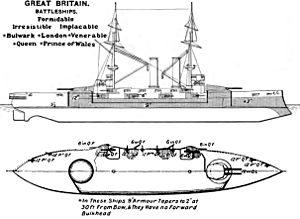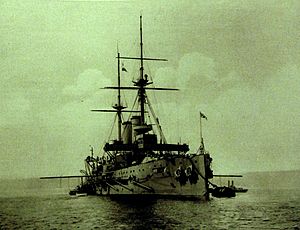HMS Formidable (1898) facts for kids

Painting of HMS Formidable, Sept. 1898
|
|
Quick facts for kids History |
|
|---|---|
| Name | HMS Formidable |
| Ordered | 1897 Programme |
| Builder | Portsmouth Dockyard |
| Laid down | 21 March 1898 |
| Launched | 17 November 1898 |
| Completed | September 1901 |
| Commissioned | 10 October 1901 |
| Fate | Torpedoed and sunk, 1 January 1915 |
| General characteristics | |
| Class and type | Formidable-class battleship |
| Displacement | |
| Length | 431 ft 9 in (131.6 m) o/a |
| Beam | 75 ft (22.9 m) |
| Draught | 25 ft 11 in (7.90 m) |
| Installed power |
|
| Propulsion |
|
| Speed | 18 knots (33 km/h; 21 mph) |
| Range | 5,500 nmi (10,190 km; 6,330 mi) at 10 knots (19 km/h; 12 mph) |
| Complement | 780 |
| Armament |
|
| Armour |
|
HMS Formidable was a powerful warship known as a pre-dreadnought battleship. She was the first ship of her kind, giving her name to the Formidable-class of battleships. She was built for the Royal Navy in the United Kingdom. Her construction began in March 1898, she was launched in November of the same year, and was fully ready by September 1901.
Formidable first served with the Mediterranean Fleet, which was a group of ships in the Mediterranean Sea. In 1908, she moved to the Channel Fleet, which protected the waters around Britain. By 1912, she was part of the 5th Battle Squadron, based at Nore.
When World War I started in August 1914, Formidable and her squadron helped protect the English Channel. They were based at Sheerness to guard against a possible German invasion. At the very start of the war, the 5th Battle Squadron helped protect the British Expeditionary Force as they traveled to France. Sadly, on December 31, 1914, while doing training exercises, Formidable was hit by two torpedoes from the German submarine U-24. She sank on January 1, 1915, and many lives were lost.
Contents
About the Formidable Class Warships
The plans for the Formidable class battleships were made in 1897. These ships were an improved version of earlier battleships like the Majestic and Canopus classes. The Formidable ships were designed to be larger, like the Majestic class, but with stronger Krupp armour like the Canopus design.
These new battleships also had bigger and more powerful main and secondary guns. Their shape was also improved, making them better protected and just as fast as the Canopus class.
Size and Power of Formidable
Formidable was about 431 feet 9 inches (131.6 m) long, which is longer than a football field! She was 75 ft (22.9 m) wide and sat 25 ft 11 in (7.90 m) deep in the water. She weighed about 14,500 long tons (14,700 t) (long tons) normally, and even more when fully loaded. Her crew was made up of 780 officers and sailors.
The Formidable-class ships were powered by two large engines that used steam from twenty Belleville boilers. These boilers sent steam up two large funnels in the middle of the ship. This powerful system allowed the Formidable-class ships to reach a top speed of 18 knots (33 km/h; 21 mph).
Weapons and Protection
Formidable had four very large 12-inch (305 mm) guns, placed in two gun turrets at the front and back of the ship. These guns could turn all the way around and load from any direction. She also had twelve smaller 6-inch (152 mm) guns, placed in special armored sections called casemates.
For defense against smaller, faster ships like torpedo boats, she carried ten 3 in (76 mm) guns and six 47 mm (1.9 in) guns. As was common for battleships back then, she also had four 18-inch (457 mm) torpedo tubes built into her hull, below the waterline.
To protect herself, Formidable had a thick armored belt around her middle, which was 9 inches (229 mm) thick. The walls inside the ship (called bulkheads) were also very thick, between 9 to 12 in (229 to 305 mm). Her main gun turrets had sides that were 8 to 10 in (203 to 254 mm) thick, sitting on top of 12 in (305 mm) armored bases called barbettes. The smaller gun sections had 6 inches (152 mm) of Krupp steel armor. The conning tower, where the ship was commanded from, had 14 in (356 mm) thick sides. She also had two armored decks, 1 and 3 in (25 and 76 mm) thick, to protect from attacks from above.
Formidable in Service
HMS Formidable started being built at Portsmouth Dockyard on March 21, 1898. She was launched into the water on November 17, 1898. At the time of her launch, she wasn't fully finished. She was launched mainly to free up the building area so another battleship, HMS London, could start construction.
Formidable was finally completed in September 1901. She officially joined the Royal Navy on October 10, 1901, to serve in the Mediterranean Fleet. In September 1902, she visited the Aegean Sea for training exercises. The next year, she escorted the royal yacht HMY Victoria and Albert when the King visited the Mediterranean.
She had a major repair in Malta from 1904 to April 1905. In April 1908, she moved to the Channel Fleet. On August 17, 1908, she was taken out of service at Chatham Dockyard for another repair. She returned to duty on April 20, 1909, joining the 1st Division of the Home Fleet at the Nore. On May 29, she moved to the Atlantic Fleet. In May 1912, Formidable was assigned to the 5th Battle Squadron in the Second Fleet, still at the Nore. She stayed there until World War I began in August 1914. All her hard work during this time caused her engines to have serious problems.
Formidable in World War I
When World War I began, Formidable and the 5th Battle Squadron were based at Portland. Their job was to defend the English Channel. After helping to safely transport the British Expeditionary Force to France in August 1914, Formidable also helped move the Portsmouth Marine Battalion to Ostend on August 25.
On November 14, Formidable and the other ships of the 5th Battle Squadron moved to Sheerness. This was because there was a worry that Germany might try to invade Great Britain. The squadron was later replaced by other battleships and moved back to Portland on December 30.
The Sinking of Formidable
On December 31, 1914, the 5th Battle Squadron, led by Vice-Admiral Lewis Bayly, was doing gunnery practice off the Isle of Portland. They were supported by two smaller ships, the light cruisers Topaze and Diamond. The squadron did not have any destroyers to protect them from submarines. After the exercises, the fleet stayed at sea on patrol that night, even though there had been reports of submarines in the area. The night was clear, but the sea was rough, making it hard to spot a submarine. Admiral Bayly didn't think submarines were a big danger, so his ships sailed in a straight line at a speed of 10 knots (19 km/h; 12 mph). Formidable was the last battleship in the line, with only the two cruisers behind her.
What the British didn't know was that the German submarine U-24 had been watching the squadron all afternoon, looking for a good spot to attack. Around 2:20 AM on January 1, 1915, U-24 fired a torpedo at Formidable. It hit her on the right side, near the front funnel.
Formidable's commander, Captain Loxley, hoped to save the ship by getting her closer to shore. The other British ships didn't know what had happened at first. But when Formidable turned out of line, Topaze sped up to see what was going on. Twenty minutes later, when Topaze reached Formidable, the battleship was already leaning 20 degrees to the right. Captain Loxley had already given the order to abandon ship. Some men tried to save the ship by flooding other parts to balance it, which helped reduce the lean, but Formidable was very low in the water.
Around 3:05 AM, U-24 fired another torpedo at the damaged Formidable. This one hit her again on the right side, near the front. Topaze, joined by Diamond, started trying to rescue the crew, but the rough seas made it very difficult to get men onto their ships. Formidable stayed afloat for another hour and forty minutes. At 4:45 AM, she began to flip over and sink by the front. She stayed afloat for a few more minutes with her back end in the air before sinking completely. Captain Loxley was last seen on the bridge, calmly making sure everyone was leaving the ship.
Diamond managed to rescue 37 officers and crew from the water. A fishing boat called Provident picked up 73 more crew members from one of Formidables lifeboats around midday. Another one of Formidables smaller boats, a pinnace, managed to reach Lyme Regis after 22 hours at sea, saving another 47 men. In total, 35 officers and 512 men were lost when Formidable sank.
An investigation by the Admiralty (the British Navy's headquarters) found that it was too risky to do training exercises in the Channel without destroyer protection. Admiral Bayly was removed from his command because he didn't take enough steps to protect his ships from submarine attacks.
Wreck Site
The place where Formidable's wreck lies is now a protected site under the Protection of Military Remains Act 1986. This means it's a special place that can't be disturbed, honoring those who were lost.
Images for kids
-
HMS Formidable in Plymouth Sound, painted by Charles Dixon





